If you’ve been out West for enough years or enjoy Western novels, you know being snakebit may not mean a snake actually sank its fangs into you. Just ask Amtrak, snakebit from the get-go this travel season.
Train No. 4, the Southwest Chief, usually runs close to on time from Los Angeles to Chicago. And Amtrak tries hard to mimic the travel experience from the days when the Santa Fe Railway sped the Super Chief across the desert and plains on blazing schedules at speeds occasionally topping 100 mph.
But that was then, and this is now:
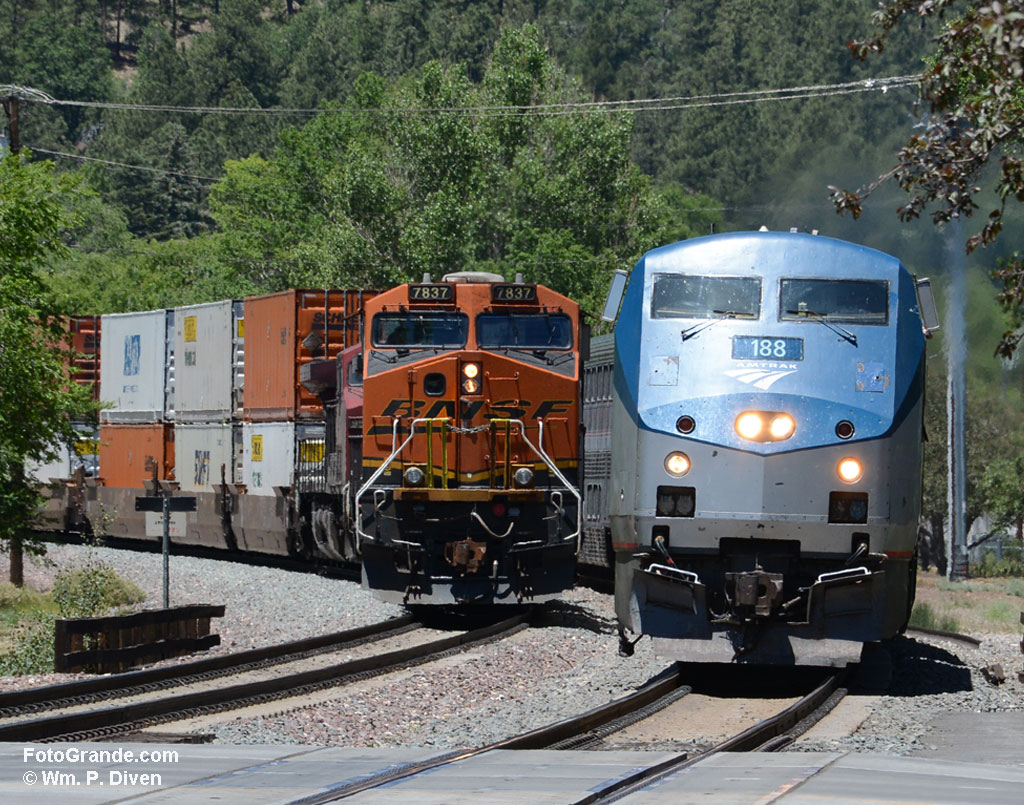
The Southwest Chief pulling into Flagstaff 7+ hours late passes a stopped freight train. Photo © William P. Diven.
Trouble brewed on a Tuesday evening last month even before Amtrak’s Chief rumbled out of Los Angles Union Passenger Terminal. Some problem put the diner out of service–“bad ordered,” in railroad parlance–so Amtrak hauled out a replacement normally assigned to the LA-Seattle Coast Starlight. By the time the cars were switched out and in, the Chief departed about 9 p.m. just under three hours late. At least passengers on the nearly sold-out train could now eat more than nuked treats from the lounge-car café.
I was in Flagstaff, Ariz., as this little drama played out checking Amtrak.com for progress reports since this train was to pick a friend and me up at 4:21 a.m. for our return to Albuquerque. Knowing the Chief would make up little of that three hours, I reset my alarm for later, and later.
The Chief stalled next at Needles, Calif., when the baggage car behind the locomotives quit passing electrical power to the rest of the train. The crew switched the bad ordered car to the back of the train restoring air conditioning, water pressure and toilet flushing to the sleepers and coaches. Now more than five hours late and disrupting dispatching on host BNSF Railway, the Chief slipped further behind while fighting its way through heavy freight traffic. Meanwhile dozens of passengers from Flagstaff and the Grand Canyon assembled at the station loitering under the No Loitering signs. Overheard discussions faulted the train crew for the delay, and one guy found a way to pin it on President Obama. Ultimately we arrived in Albuquerque 8 1/2 hours late but weren’t worried about missing connections farther down the line as were untold numbers of other passengers..
- For details of Amtrak’s on-time performance and a brief trashing of national operations, see this July 10 posting in the Washington Post Wonkblog.
Fast forward to last week on the same train leaving the LA Basin and halfway up Cajon Pass when the power generator in one of the two locomotives failed shutting down all but minimal lighting in the cars. That was blamed on low coolant, and after a short delay the crew restarted the generator, which conked out again about 10 p.m. fortunately in the rail center of Barstow. There the crew lucked into a parked Amtrak engine and opted to add it to our train rather than chance crossing the desert in the middle of the night without air conditioning and working restrooms. We finally sped off after two hours of increasing heat and the odor of bad-ordered toilets.
None of this was the crew’s fault, and it’s a real stretch to blame Obama although he’s done little to make Amtrak and its long-distance trains a priority. Blame Congress, if you want, since it nickel-and-dimed Amtrak from the beginning in the false belief the system can be squeezed into paying for itself. (Maintenance is suffering, and the Chief now relies on 11 On-Board Services (OBS) people down from 25 to serve and ride herd on hundreds of passengers in nine cars of a sold-out two-level train.)
Hang some of the trouble on the freight railroads who mostly consider Amtrak a nuisance on their tracks even though it was created 43 years ago to end their losses on passenger trains and save the system from collapse. And then lay the rest of issues on the American people who, if they think about it at all, don’t see value in a first-class nation having a first-class rail network like we once did.
About all that saved the Southwest Chief from mutiny during my three trips this year is the Los Angeles-based OBS crew laboring mightily to keep passengers happy and the cars clean with minimal sleep during their 36-hour run and short turnaround in Chicago (train operating crews change frequently). Last week, on the first leg of our trip, a mechanical problem stopped the daylong commuter run from Oakland before the train even left the yard. That and further delays foiled the LA connection, and a couple dozen of us, including Boy Scouts headed to Philmont Scout Ranch, were bused from Bakersfield to San Bernardino to intercept the Chief about two hours into its run.
From the bus I called Amtrak customer service and was told the Chief’s diner would be closed by then even though our tickets included meals. My sense of defeat grew ever darker during the 160-mile bus trip as did hunger after surviving on snacks all day. My normally tolerant wife swore she would never ride Amtrak again. Ugh. But once aboard the Chief, joy — expansive, almost tearful joy — blossomed when the dining car steward kept the kitchen open. It’s all about customer service, she told me. That simple act totally saved the trip.
Still, before leaving the diner, another aspect of the nickel-and-diming was revealed. In March heading to LA, I got the last Scotch on the train (see my post Amtrak’s Last Scotch). Last month the Chicago-bound Chief exhausted its meager Scotch supply before it reached New Mexico with another evening still to go. So last week, planning ahead, I bought two Scotches in the diner and discovered those 50 mL miniatures of Dewar’s represented the diner’s entire supply.
I don’t know how much Scotch Amtrak begrudges the lounge car, but it’s obviously not much. And no, this isn’t about alcohol, just a cocktail or two of your choice traditionally being one of the comforts of rail travel as you settle into a good dinner or into the lounge car for sightseeing, conversation or the space and mobility you won’t find on a bus or in a coach airline seat.
Amtrak remains a punching bag for the small-government crowd, a hero to the energy-efficiency crowd and a source of real concern here in New Mexico. Amtrak’s contract with BNSF to use its 130-year-old route from central Kansas across southeast Colorado and over Raton Pass to Albuquerque expires at the end of 2015. The three states and their congressional delegations and legislatures are going roundy-round about helping to pay for track improvements on the line used almost exclusively by Amtrak.
Absent a deal and assuming the Chief keeps running, the trains could switch to BNSF’s main freight line through northwest Texas bypassing New Mexico stations in Raton — the second busiest of New Mexico’s seven Amtrak stops — where 5,000 Boy Scouts detrain annually for Philmont Scout Ranch, Las Vegas, where an entrepreneur is restoring a historic trackside hotel, Lamy, the closest stop to Santa Fe, and Albuquerque, our biggest city. That would be just another setback in a state peddling tourism and recreation and starving for economic development but still stuck in the recession as federal budgets shrink and its neighbors move ahead.
- Amtrak New Mexico station statistics (PDF from FotoGrande.com)
On Saturday Amtrak President Joe Boardman rolled through northeast New Mexico on a special train intended to highlight the issues and rally the communities (but two days later still not deemed worthy of coverage by the Albuquerque Journal). On a driving detour to Philmont, Boardman told the Sangre de Cristo Chronicle Amtrak is committed to the Chief and its current route. New Mexico transportation Secretary Tom Church talked nice about the Chief but repeated Gov. Susana Martinez’s position of not wanting to put any money into it. Meanwhile she takes credit for a tax break first approved in the previous administration that helped lure a Union Pacific freight terminal out of Texas and into the southern part of the state. BNSF won a similar fuel-tax deduction under her watch.
Martinez and Church also cite the anti-donation clause of the state Constitution that prohibits state aid for private businesses, although politicians have found numerous dodges around that when they want to. Amtrak, while providing a publicly funded public service, is considered a private corporation. BNSF meanwhile is asking the states and Amtrak to pony up about $100 million for the track upgrades.
Also aboard the special was Sen. Martin Heinrich, D-N.M. “All of those communities along the tracks in northeastern New Mexico realize the Southwest Chief is one of those things that ties them together and connects them to rest of state and country,” he told me. “Rail is always one of the most efficient means of travel in existence, and as energy costs creep up over time, environmental efficiency is built in. It’s also a smart use of dollars.”
At the opening of the new Union Pacific terminal in May, I also spoke to Sen. Tom Udall, D-N.M., who, like Heinrich, is supporting Amtrak and the Southwest Chief, and Rep. Steve Pearce, R-N.M., who has the Los Angeles-New Orleans Sunset Limited running through three counties in his district. Pearce is gung-ho about the efficiencies of freight railroading, but when it comes to Amtrak, “We Republicans say lets get it effective and efficient.” A week after the terminal opening he again voted to cut Amtrak’s funding.

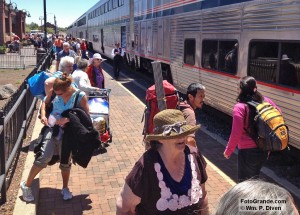
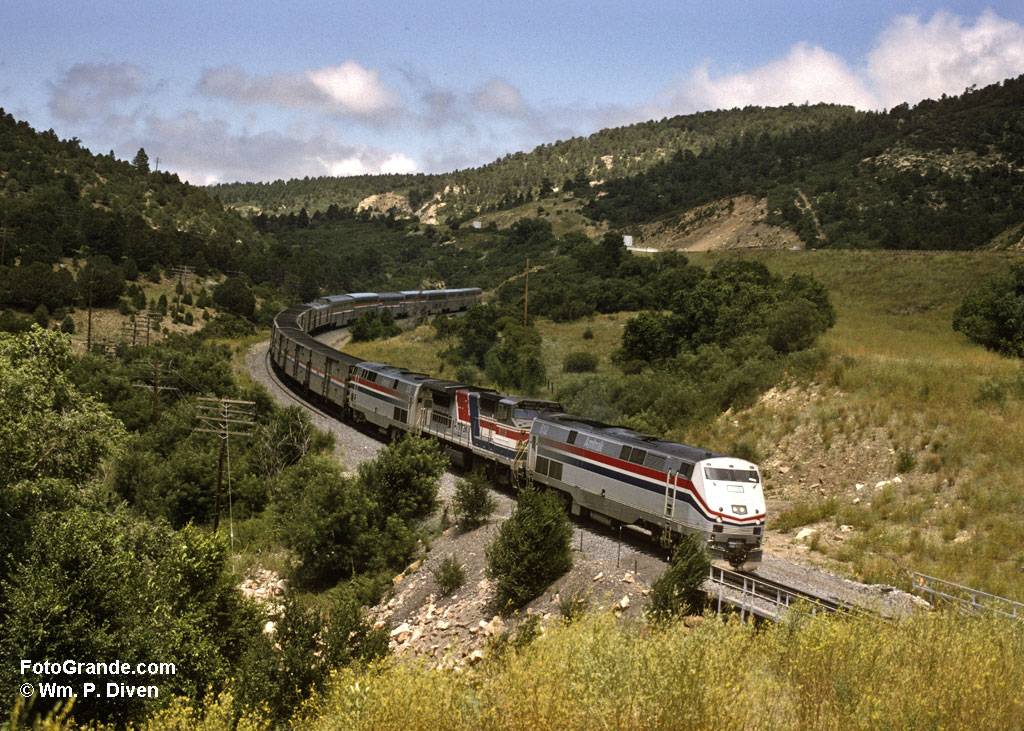
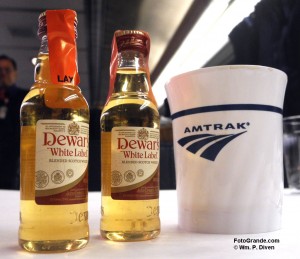
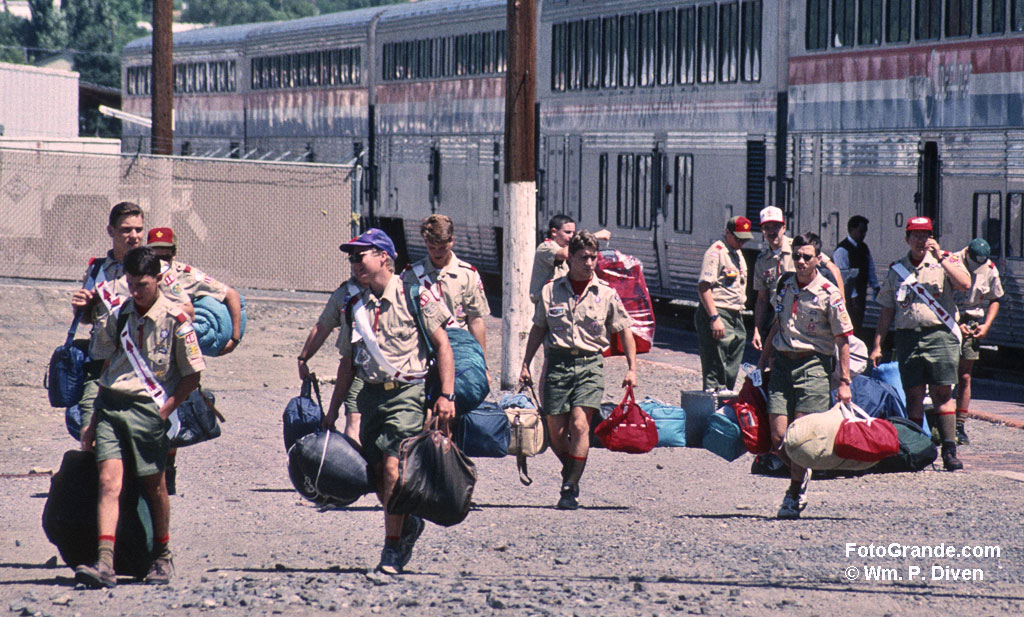
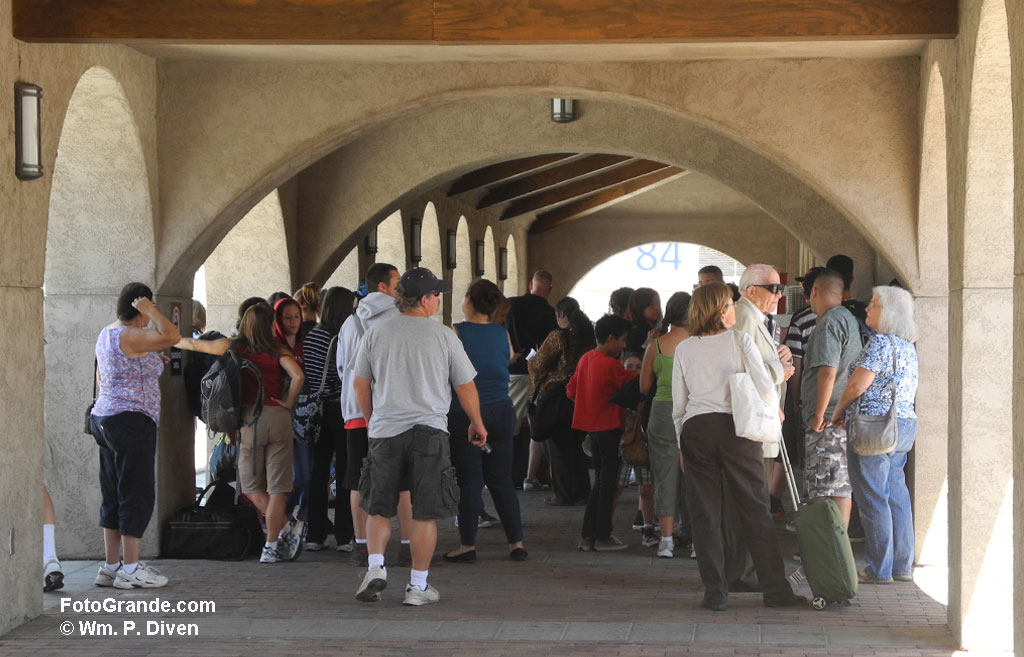

Mr. Diven:
I have had a love/hate relationship with train travel for some time. I took a lovely trip around the country in the 90’s with my then-young son and loved every minute. We weren’t on a hard time schedule and usually arrived at our locations late. But the learning experience from seeing the country slowly, meeting interesting folks, and following the guides enlightened us both.
I had a similar experience a few winters ago on sleeper cars from New York City to Portland, Oregon. Our return trip was a nightmare as we got stuck in Minot, SD for over 12 hours in -20 degree temperatures with little or no communication about what was happening and what were the chances of a fix.
I recently took a trip from CT to Baltimore and my faith was restored. I know that Amtrak service in the Northeast Corridor is important. The train was packed but not uncomfortable. The amenities aboard (including wifi) made the trip pleasant.
I too long for the days when we would all understand that a trip doesn’t have to be a sprint, and I would like to think that those responsible for spending our taxes can see that a little investment in this important piece of infrastructure would go a long way.
As usual, your research made your very personal story interesting. I cannot wait for your next missive.
Ouch! I wish the govt considered Amtrak a for-real transportation option and not some kind of welfare. I’ve enjoyed/not enjoyed traveling with them over the years.
Keep up the good work on this issue Bill.
I just returned from a few days of covering for the vacationing publisher/managing editor/news editor/senior reporter, Martin Salazar, at the Las Vegas Optic and had the pleasure of covering a county commission meeting where among other things they approved a resolution calling on the state’s congressional delegation to help keep the train running especially since the town is anticipating a revival of sorts now that the old Harvey House in the historic district next to the refurbished train station is to be renovated. This is a huge issue for this community as it embraces tourism more now than ever and the commission cited some big economic and employment numbers in their resolution. Can you tell us more about this relationship between BNSF and Amtrak, the whole maintenance thing and what if any impact the deal BNSF had with the state which has since been rescinded plays in all of this?